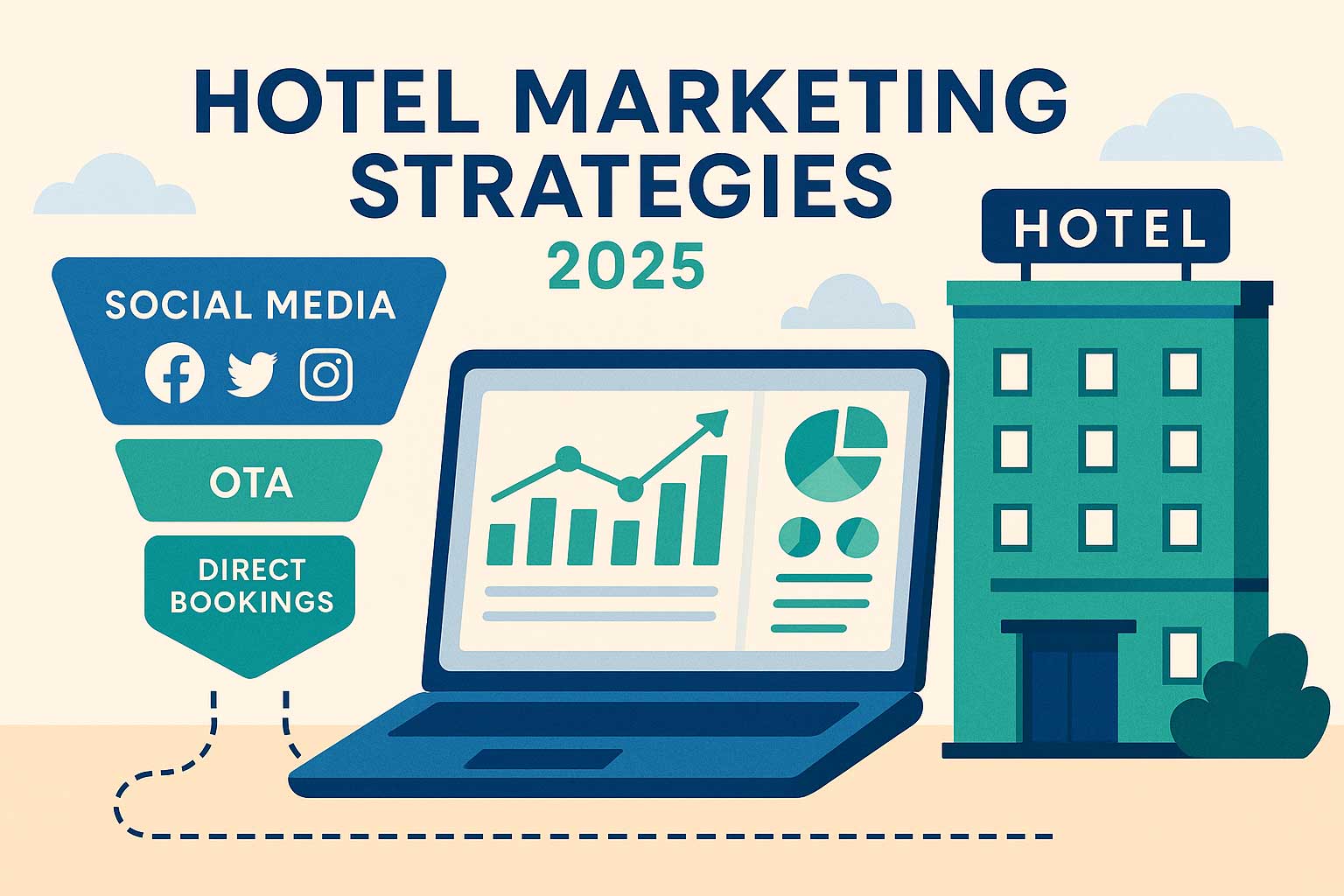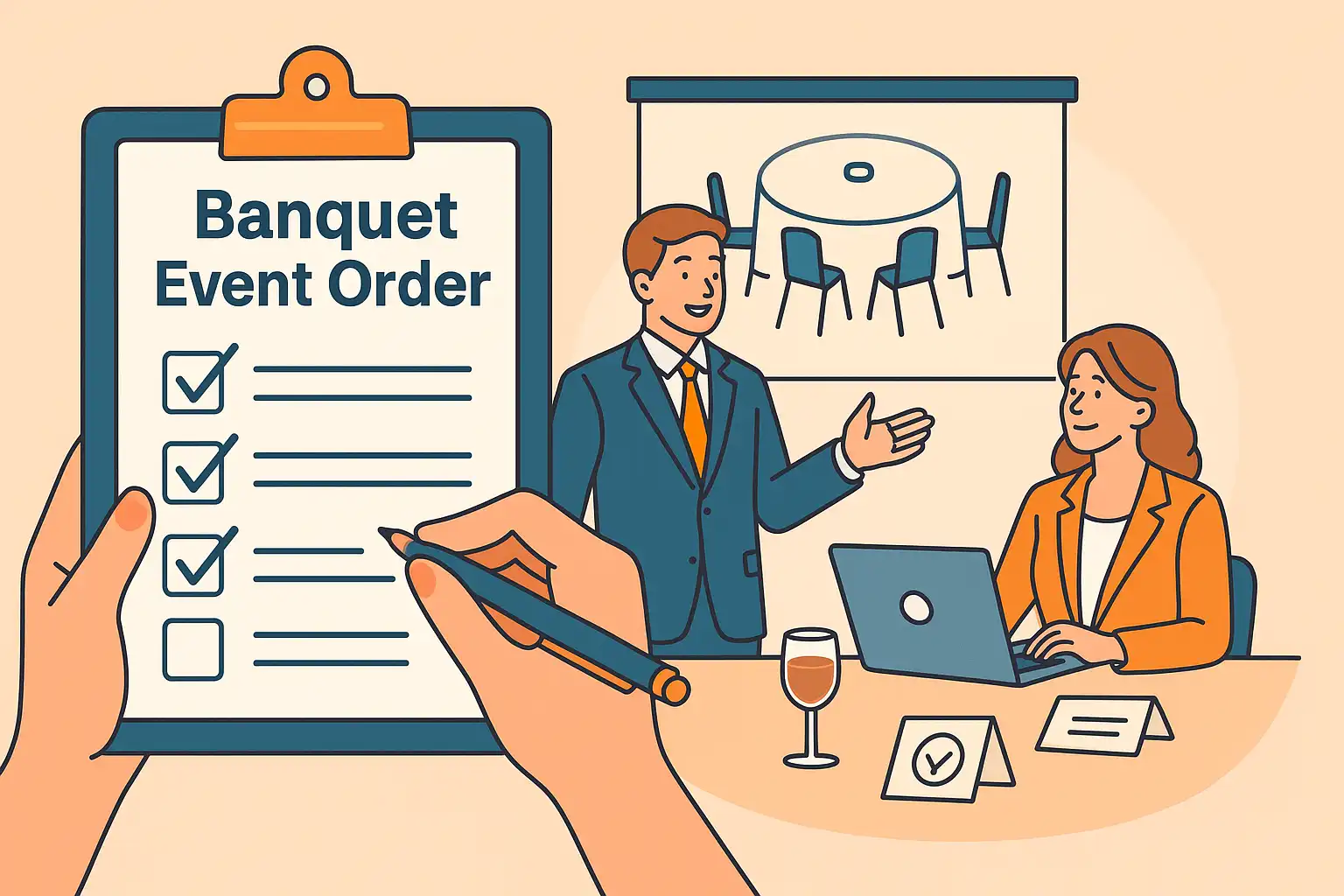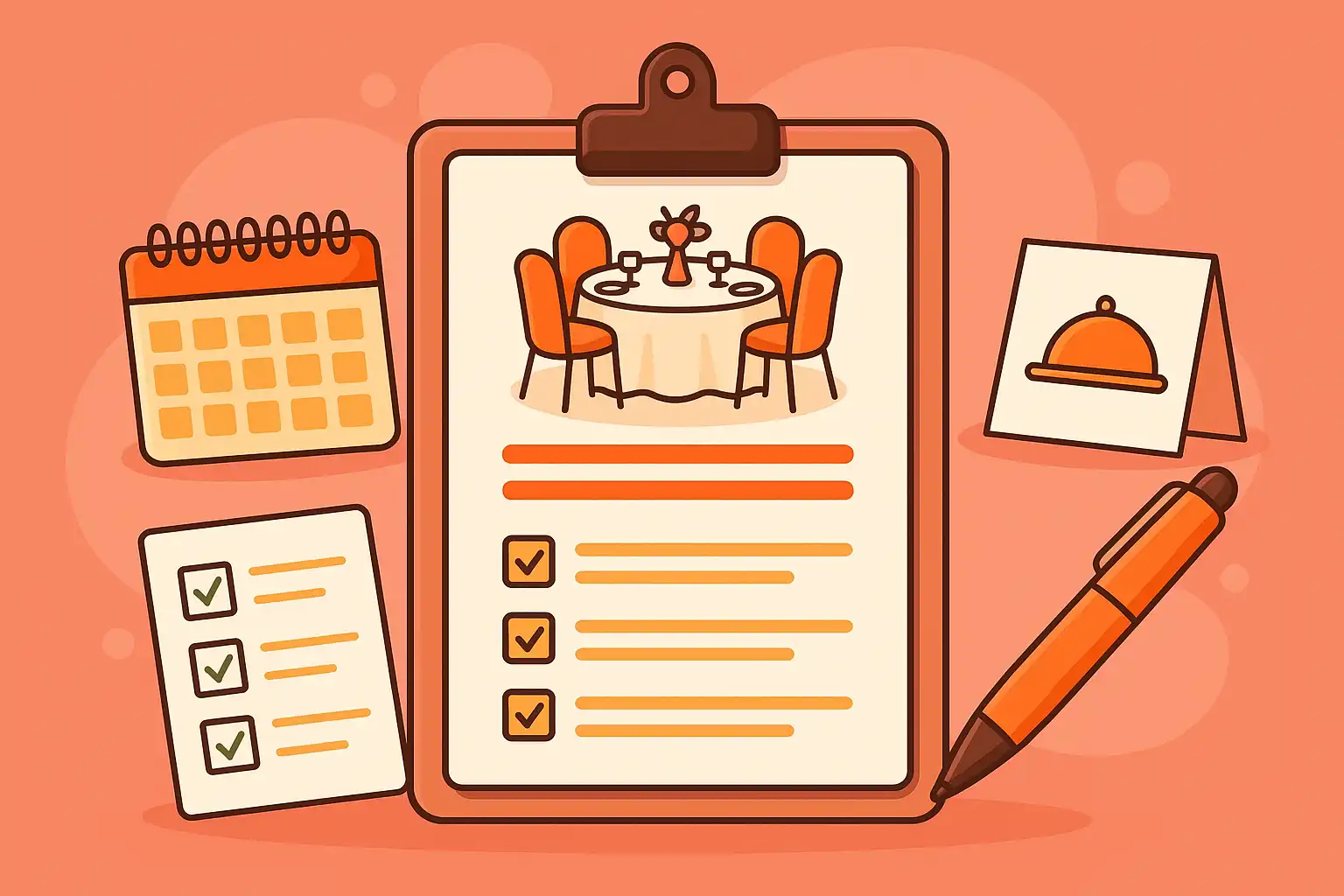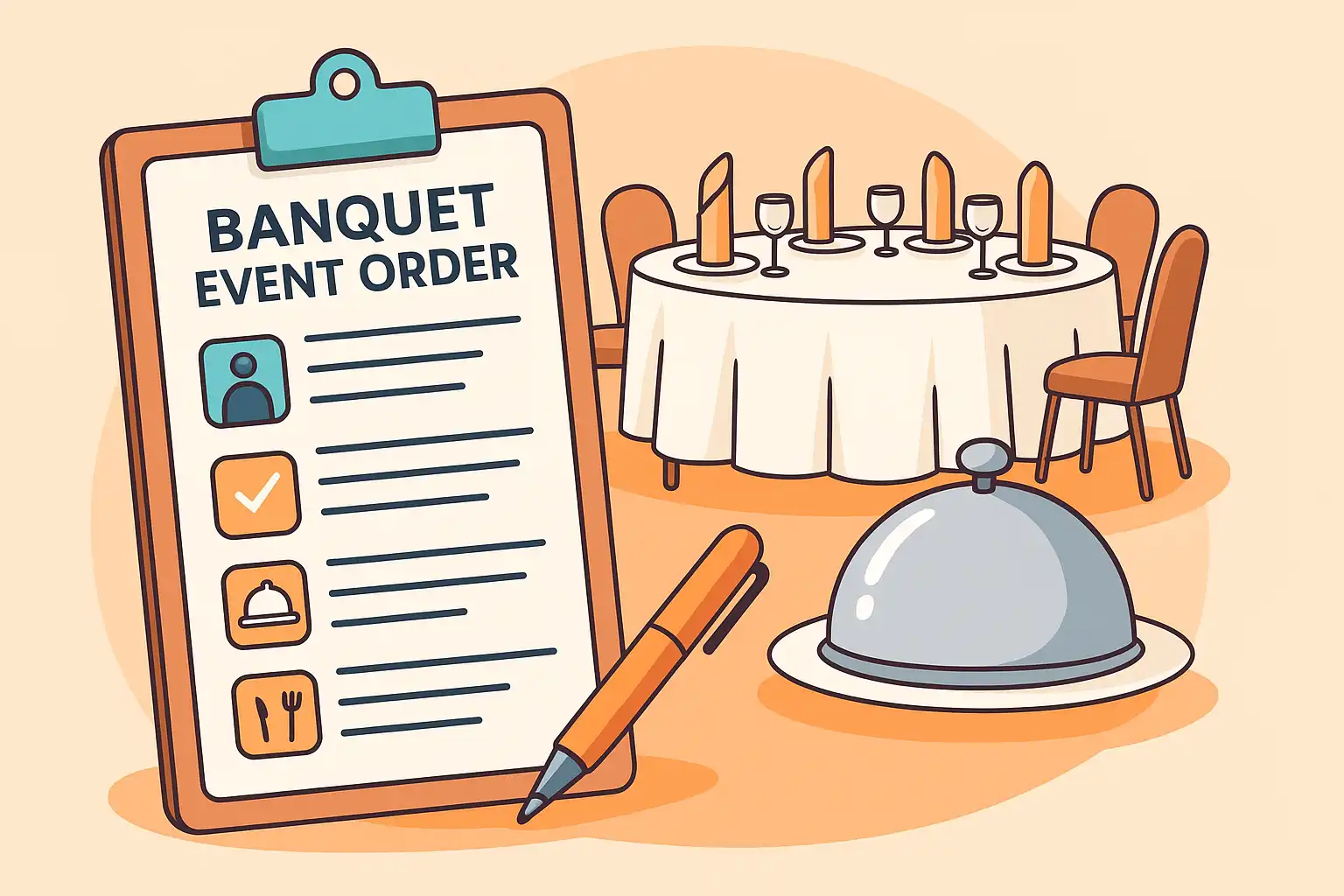Banquet Event Order (BEO) Hotel: Complete Guide for Professionals
Oct 20, 2025
 Mika Takahashi
Mika TakahashiPopular Categories
Hotel Technology & InnovationHotel Operations OptimizationDigital MarketingIndustry TrendsRevenue ManagementHospitality Industry
Popular Categories
Trending Post

Hotel Walk Letter Template: Professional Guest Communication

Online Travel Agents: What They Are and How They Work

Hotel Security Systems: Modern Protection Solutions

Hotel Advertising: Complete Guide to Boost Bookings and Revenue

25 Hotel Marketing Strategy Ideas for 2025: Complete Guide

AI Reservation Agent: Revolutionizing Hotel Booking and Guest Experience

PMS Communication: Streamlining Property Management Through Effective Guest Messaging
Table of contents
In the fast-paced world of hotel event management, even a small missed detail can turn what should be a flawless wedding reception into a stressful scramble. Whether you’re organizing a corporate dinner for 300 guests or an intimate anniversary celebration, the secret to a smooth, successful event often lies in one key document: the banquet event order.
Hotels that use detailed banquet event order systems see up to 35% fewer operational hiccups and enjoy much higher client satisfaction. Yet, many hospitality pros still find themselves juggling event details, coordinating between departments, and trying to keep everything on track. This comprehensive guide will walk you through everything you need to know about banquet event orders in hotel operations—from the basics to advanced strategies.
You’ll learn how to craft detailed BEOs that not only protect your hotel legally but also boost efficiency, discover the latest event management software that can make your planning process effortless, and pick up best practices that set top hotels apart from the rest.

What is a Banquet Event Order in Hotels?
Think of a banquet event order hotel as the master plan that keeps every hotel event running like clockwork—from small corporate meetings to grand wedding receptions with hundreds of guests. This detailed document acts as both a planning tool and a legally binding contract between the hotel and the client, making sure everyone involved knows exactly what’s expected and when.
Imagine Marriott hosting a corporate conference for 300 guests on March 15th. The BEO would spell out everything—from when the audiovisual equipment arrives to the exact time dinner service kicks off—creating a perfectly synchronized timeline that keeps all hotel departments on the same page.
This operational blueprint guides everyone, from kitchen staff handling special dietary restrictions to housekeeping making sure the venue shines. Every department head, whether it’s the catering manager or the engineering team, depends on this document to know their roles and when to act during the event.
Keep in mind that each event needs its own banquet event order (BEO), even if it’s part of a multi-day conference across several ballrooms. For example, a three-day pharma conference might have separate banquet event orders for the opening reception in the Harbor View Ballroom, daily lunches in the Executive Conference Center, and the closing gala in the Grand Ballroom. This way, each part gets the attention and resources it deserves.
Why Hotels Need Banquet Event Orders
Skipping proper banquet event order hotel procedures can lead to costly mistakes that hurt your hotel’s reputation and bottom line. Picture double-booking the Grand Ballroom for a pharmaceutical product launch and a golden anniversary party on the same Saturday night—an error easily avoided with detailed BEO management but one that can cause canceled contracts, legal headaches, and unhappy clients.
Banquet event orders ensure smooth teamwork between hotel departments—from F&B and housekeeping to engineering and sales. When the catering team knows exactly when to start plating appetizers and housekeeping knows which linens to prepare for each table setup, everything flows effortlessly. This coordination is especially crucial during busy wedding seasons, when hotels might juggle five events across different venues at once.
Using BEOs also helps hotels increase revenue by optimizing resource use and spotting upselling chances. When catering managers have accurate guest counts and dietary info well ahead of time, they can negotiate better supplier deals and suggest premium add-ons like fancy wine pairings or upgraded floral arrangements. Hotels with strong BEO systems often see revenue jumps of 47% year-over-year thanks to better efficiency and happier clients.
From a legal standpoint, banquet event orders protect hotels by clearly documenting agreed services, pricing, and cancellation policies. If a client disputes the final bill or claims promised services weren’t delivered, the signed BEO is your go-to proof. It’s invaluable for insurance claims, vendor disputes, or any legal issues related to the event.
Plus, the BEO sets clear accountability. If something goes wrong, it helps pinpoint whether it was a hotel mistake, a client change, or an outside vendor issue. This clarity speeds up problem-solving and keeps client and vendor relationships healthy.
Essential Components of Hotel Banquet Event Orders
To create a banquet event order that guarantees flawless events, you need to cover a lot of ground. Each piece plays a key role in keeping everything running smoothly, and missing details can lead to unhappy clients and operational headaches.
Event Details and Client Information
Every great hotel BEO starts with clear event details and client info. Write down the full event name, like “Johnson Wedding Reception - Saturday, June 10th, 2025,” along with exact start and end times—say, 6:00 PM arrival for cocktail hour and 11:00 PM wrap-up. These details help every hotel team plan staffing and coordinate their work around the event.
Make sure to note guest counts carefully, including guaranteed minimums and maximums, like “150 guests guaranteed, max 175.” This helps the catering team prepare the right amount of food while leaving room for last-minute additions. Don’t forget to include contact info for the main event organizer, day-of coordinator, and any backup contacts, complete with phone numbers and emails for quick communication during setup and the event itself.
Specify the event type—corporate dinner, wedding, charity gala, product launch—since this affects service style and staffing. A black-tie gala requires different prep than a casual company picnic, so your BEO should reflect those differences clearly.
Venue and Room Setup Requirements
Avoid confusion by detailing exactly which hotel spaces will be used and how they should be arranged. Specify locations like “Crystal Ballroom for dinner, Terrace Garden for cocktail reception, Executive Boardroom for VIP meet-and-greet” and include floor plans showing table layouts and traffic flow.
Be precise about table setups, for example: “20 round tables seating 8 guests each with 4-foot aisles, plus a sweetheart table center-stage with clear sightlines.” Include dance floor placement, stage needs, and accessibility accommodations to comply with ADA standards.
Don’t overlook décor details, either. Specify things like “navy blue and gold uplighting, custom ivory linens with matching napkins, fresh white rose and eucalyptus centerpieces, and ambient lighting dimmed to 40% during dinner.” These help the hotel event team bring the client’s vision to life.
Food and Beverage Specifications
Clear menu documentation is a must to avoid kitchen mix-ups and meet dietary needs. List the full menu with service style, like “plated dinner featuring herb-crusted salmon and roasted veggies, followed by chocolate dessert course, served family-style with wine pairings.”
Detail dietary restrictions with guest counts: “12 vegetarian meals (grilled portobello with quinoa), 3 gluten-free (herb chicken with rice pilaf), 1 kosher meal.” This ensures the kitchen prepares the right dishes safely, avoiding allergy risks.
Include beverage info with timing: “premium open bar 7:00 PM - 11:00 PM, wine service during dinner 8:00 PM - 9:30 PM, coffee and tea starting at dessert.” Add any special requests like signature cocktails or late-night drinks.
Audiovisual and Technology Needs
Many modern hotel events require audiovisual gear, so document all AV needs clearly. For example: “wireless mics for bride, groom, and best man speeches; two 60-inch monitors at room entrance for seating charts; projector with HDMI for slideshow during dinner.”
Lighting affects mood, so specify: “dimmable lights for dinner ambiance, spotlights on podium for toasts, color-changing LED uplights synced with music for dancing, emergency lighting for outdoor terrace.”
Note technical support needs like sound engineers or lighting techs, and include Wi-Fi requirements: “high-speed internet for 200 devices, live streaming for remote guests, backup connection for payment processing.” Some events need dedicated bandwidth that could affect hotel guest services.

Step-by-Step Process for Creating Hotel BEOs
Creating a hotel banquet event order that hits every mark takes a clear, proven process. Here’s how the best hotels do it:
Start with a client consultation in the sales office to gather basics like guest count, event date, budget, and special requests. Understand the planner’s vision and any unique needs that might influence venue choice or service style.
Next, walk the client through available spaces—Harbor View Ballroom, Garden Terrace, Executive Conference Center—discuss room setups, AV options, and accessibility. Take notes on client preferences and reactions.
Draft the preliminary BEO within 48 hours, including menu choices, room setup, timing, and pricing estimates. Fast turnaround shows professionalism and keeps details fresh.
Schedule a revision meeting within a week to review the draft, make changes (like switching from buffet to plated service or adding AV gear), and clarify expectations.
Finalize the BEO with signatures from both parties and distribute copies to all hotel departments at least 72 hours before the event. This gives teams time to prepare without last-minute rush.
Hold a pre-event meeting 24 hours before the event with the banquet captain, executive chef, housekeeping supervisor, and vendors to confirm guest counts, timing, and roles.
Hotel BEO Management Technology and Software
More hotels are turning to event management software to simplify BEO creation, sharing, and tracking. These tools reduce errors, improve communication, and allow real-time updates when client needs change.
Popular Hotel BEO Software Solutions
Tripleseat is a favorite among major chains like Hilton, offering menu management, floor planning, automated billing, and mobile access for event staff. Its reporting helps track profitability and spot upselling chances.
Planning Pod integrates with hotel PMS systems for automatic guest billing and room blocks. Clients, planners, and staff can collaborate on BEOs in real time, cutting down on confusing email chains.
Perfect Venue suits boutique hotels managing 50-200 events yearly, providing customizable templates, automated reminders, and basic reports to keep things professional without complexity.
Pricing varies widely—from $200/month for small properties to $2,000/month for large resorts with advanced integrations. Most providers offer tiered plans based on event volume and user numbers.
Integration with Hotel Management Systems
Top BEO software connects with hotel Property Management Systems like Prostay or Opera for automatic billing and smooth room block coordination. This cuts down on manual data entry and ensures charges appear correctly on guest folios.
Integration with accounting systems helps track event revenue and allocate costs automatically across departments. Extra ingredient orders or extra cleaning services flow through billing without manual work.
Mobile apps let banquet staff access BEOs on tablets during setup, making real-time tweaks without returning to the office. Messaging features keep departments in sync during events.
Real-time updates are a lifesaver when guest counts drop from 200 to 185 two days before the event. The software adjusts orders, table setups, and staffing, alerting all teams instantly.
Best Practices for Hotel Banquet Event Orders
Turning BEO management from reactive to proactive takes proven strategies. Leading hotels worldwide use these to tackle common challenges and raise the bar.
Standardize BEO templates for common events like board meetings, weddings, and galas. Include typical services, timing, and pricing, but allow customization. Standardization speeds creation and ensures consistent service.
Use version control with clear numbering (v1.0, v1.1, etc.) to track changes and approvals. This keeps everyone on the latest page and prevents confusion.
Require approvals from both catering manager and client before finalizing. Set deadlines like “all changes must be approved 72 hours before event” to avoid last-minute chaos. Document who can approve what changes.
Hold pre-event briefings 48 hours before big events with all department heads and vendors. Review details, identify potential issues, and coordinate execution.
Keep digital backups in the cloud accessible 24/7, with mobile access for staff on the go. Automatic backups preserve all versions for future reference.
Be specific in your language—avoid vague terms like “elegant setup.” Instead, say “crystal chandeliers with warm white lights, ivory linens with gold chargers, fresh white rose centerpieces.” This precision prevents misunderstandings.

Common Hotel BEO Challenges and Solutions
Even the best hotels face familiar hurdles with banquet event orders. Knowing these helps you stay ahead.
Last-minute guest count changes are common, especially for weddings. Keep a 10% buffer in room capacity and food prep to handle reasonable increases. Set clear policies on change deadlines and fees to protect profitability.
Communication gaps between departments can cause errors. Use centralized BEO distribution that sends automatic updates and requires receipt confirmation. Highlight urgent changes with color codes or flags.
Managing multiple events simultaneously is tricky during busy weekends. Use color-coded BEOs to assign staff, equipment, and resources clearly, and create detailed schedules to avoid double-booking.
Staff turnover can leave knowledge gaps. Train new employees on BEO reading and execution, use video demos, and assign mentors for their first events.
Technology failures can disrupt operations. Keep printed backups of active BEOs updated daily, and ensure key staff know how to use them if digital systems fail.
Vendor coordination is another challenge. Include vendor contact lists with arrival times and setup needs, and assign a single hotel contact to manage vendor communications and resolve conflicts.
Hotel BEO Legal and Financial Considerations
Banquet event orders carry important legal and financial weight. Careful wording and clear policies help manage risks and keep clients happy.
Include clear cancellation policies with notice requirements and penalties, like “72-hour notice required, 50% deposit non-refundable.” Make sure clients acknowledge these when signing. Address partial cancellations for big guest count drops.
Outline payment terms—deposits, final payments, methods, and deadlines. Specify extra charges for overtime, rentals, or last-minute menu changes to avoid billing disputes.
Add liability clauses protecting the hotel from damages caused by client vendors, guests, or events outside your control. Require client vendor insurance and damage deposits.
Cover alcohol service rules, including local liquor laws, bartender licensing, and security needs. Include procedures for cutting off service if needed.
Detail billing terms for extra services like cleaning or emergency rentals, and set clear authorization and documentation processes.
Include force majeure clauses for emergencies or weather events, explaining cost allocation, rescheduling, and contract termination conditions. Pandemic-related clauses have become especially important.
Mastering banquet event order management sets exceptional hotels apart, helping deliver flawless events that build lasting client relationships. From avoiding double-booking disasters to coordinating multiple departments smoothly, a well-managed BEO is the foundation of operational excellence.
Hotels investing in strong BEO processes, supported by smart technology and trained teams, enjoy happier clients, fewer mistakes, and higher revenues through efficiency and upselling. Detailed documentation protects against disputes, while clear roles keep everyone aligned during event execution.
As the hospitality world evolves with new tech and rising client expectations, one thing remains constant: detailed event planning documents like the BEO are essential. Hotels that perfect their BEO management position themselves for ongoing success, earning reputations for reliability and excellence that bring repeat business and glowing referrals.
Start applying these BEO best practices in your hotel today to ensure seamless event execution, protect your property from risks, and create exceptional experiences that turn first-time clients into lifelong fans.
